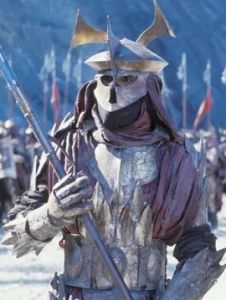by Bryan and Francis
Another Hobbit Day arrives, and with it a premier long awaited: Amazon’s The Rings of Power finally graced our screens almost three weeks previously to the day, on September 1, 2022. As might be expected, this show has been surrounded by controversy almost from the moment of its first reveal, much of it revolving around the decision to update the peoples of Middle Earth with a cast more inline with the modern world. Never ones to shy away from frank discussion, this year Bryan and Francis tackle the historical inspirations for the evil Men of Tolkien’s Third Age and in so doing address for themselves one of the problems 21st-century audiences confront when reading The Lord of the Rings.
Unlike some contemporary fantasy series, the nature of J.R.R. Tolkien’s foundational legendarium is one of stark contrast between Good and Evil. While Tolkien’s inspiration for the nature and effects of evil in Middle Earth most readily draws from a meld of Roman Catholic eschatology and Norse mythology, today’s post will turn its attention to the historical inspiration for the human societies who served Sauron during the War of the Ring, notably the Easterlings, Haradrim, and Corsairs of Umbar. Each of these peoples derive some, if not all, of their role in Tolkien’s mythos from historical rivals and competitors to Medieval European civilization.
Before starting, however, it is important to note that, as many modern critics have observed, Tolkein coded the Free Peoples of Middle Earth as white European (including and especially the telling “Men of the West”), while the forces of the Enemy are almost uniformly described as swarthy, dark-skinned, or loosely like the peoples of the central Asian steppes. This proverbial “Mumak in the room” is a fair point that should not simply be dismissed because we love the world Tolkien created. As a Briton born in South Africa who came of age during the height of the Empire, not to mention a chaired professor at the Empire’s premier university and training ground for imperial officials, it is unsurprising that even the relatively-tolerant Tolkein would craft a world shaped by subconscious racial biases. Yet this should not blind us to the many other fascinating themes of the legendarium–among them critiques of modernism, industrialization, and totalitarianism–not to mention the real, vibrant historical cultures that these peoples who fell under the sway of the Shadow in the East were heavily based on.
 Easterlings of Rhun and the Lands Beyond
Easterlings of Rhun and the Lands Beyond
The first of Sauron’s belligerent vassals who wage war against the Free Peoples are the Easterlings. Drawing inspiration from the limitations of Medieval texts as the linguist he was, Tolkien purposefully kept the name of these people from the lands of Rhun vague, just like many migratory peoples in Late Antique Rome were called “Germans” or “Goths,” with no real effort made to accurately describe their ethnic origins. All that is clear about Easterlings is that they generally fight on horseback or in chariots (known as wains), are vassals to and worshippers of Sauron, and that one of the Nazgul, Khamul, was a king among them. However, in their description and appearance, they take inspiration from the Huns, Xiongnu, and Mongols, groups of nomadic steppe peoples who invaded the urban-agrarian civilizations of the Mediterranean Sea and China throughout the ancient and medieval periods. In fact, in Gondor’s early history, several succession crises came about because Easterling or Wainrider invasions killed the king or his heirs.
 Haradrim, Men of the Southern Deserts & Jungles
Haradrim, Men of the Southern Deserts & Jungles
The next major group of Men opposed to the Free Peoples are the Haradrim, literally the “people of the South.” The Haradrim are described as having darker complexions and, distinctively, they fight on horseback and with massive gargantuan war elephants called mumakil (s. mumak). The Haradrim draw inspiration from the armies of the ancient city-state of Carthage, which deployed war elephants against Rome’s legions in the Punic Wars, as well as other civilizations such as Helenistic Egypt and the Indus River Valley states who (mostly) resisted Alexander the Great’s attempts to conquer (even more) territory for his far-flung west-Asian Empire. The topography of Haradwaith (“South-lands”) is also reminiscent of Africa, with the desert sands of the kingdom’s near reaches giving way to the dense tropical jungles in which mumakil and other beasts strange to the Men of the West dwell.
Corsairs of Umbar, Gondor’s Bane
The last and most notorious peoples in the legendarium are the Corsairs of Umbar, pirates who harass the coasts of Gondor and were pretenders to Gondor’s throne, having their origins not only in the Black (as in corrupted) Numenoreans of Umbar but also in the usurpers who lost Gondor’s civil war in the middle of the Third Age. Their role as ever-present coastal raiders invokes the tradition of the Barbary States of the Early Modern Mediterranean, Muslim Emirates nominally loyal to the Ottoman Empire that formed a loose coalition and would extract bribes and payments from foreign merchant vessels to sail through Mediterranean waters unmolested. Just like the Barbary States would raid European (Christian) merchant vessels, demanding a cut of their cargo or profits or capturing passengers for ransom, so too do the Corsairs capture and enslave Gondorians to man their fleets. While minor, the Corsairs also have other historical parallels with the Vikings in their willingness to attack and occupy the cities of Gondor themselves, most famously Pelargir, Gondor’s premier port at the mouth of the Anduin, during the War of the Ring–actions uncharacteristic of the Barbary States, but quite typical of the later stages of the Viking Age in the British Isles.
Fittingly, Tolkien’s problems with representation have been largely addressed in the new Rings of Power show through a diverse cast of actors recruited to portray both new and recurring characters in Middle Earth. It is a testament to the strength of Tolkien’s works that they can be fairly easily adapted to be more representative of the Race of Men as humanity in general. It is also revelatory of Tolkien’s scholasticism as a Medieval linguist that the human enemies of the Free Peoples draw clear inspiration from the rival states and peoples that disrupted and defeated the principalities of Western Europe throughout the Medieval and Early Modern Eras. So the next time you watch The Two Towers and see the Easterling warriors marching into the Black Gate, think about the way that the Romans or the Han Dynasty reacted to their own “Easterlings” or “Westerlings.” If the historic record can be trusted at all, it was with sheer terror and dismay at these people who strained or collapsed mighty empires.
